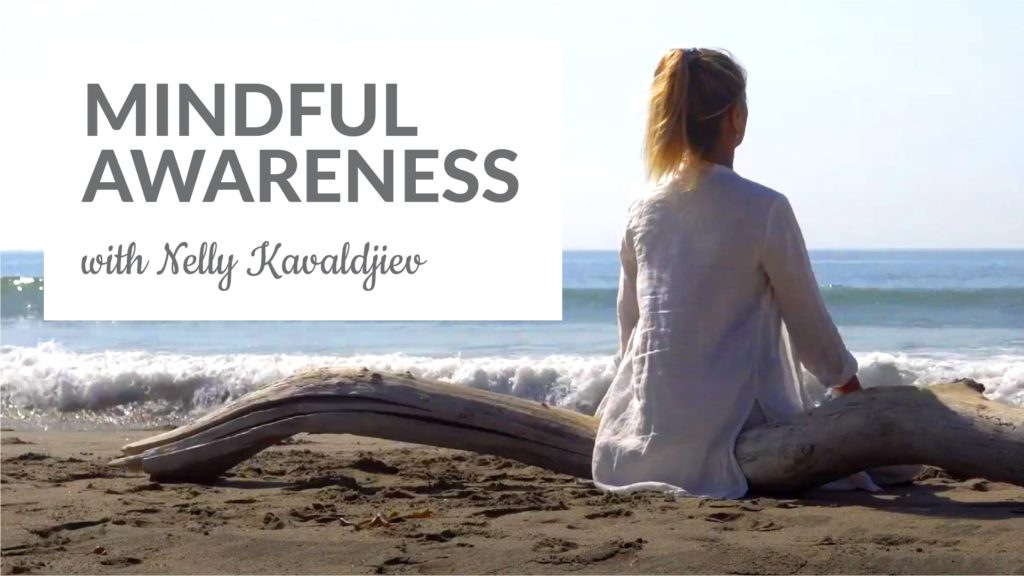What is mindful awareness? Paying attention to our inner experiences without trying to change or hold onto them; simply observing the rhythm of the breath, equally open to the comfort and the discomfort in the body, without preferences of how it needs to be – simply letting it be as it is. Notice the flow of your thoughts appearing, maybe some lingering a bit, before dissipating.
Going deeper within, we may find a particular emotion trying to grab our attention. Can we observe it without creating a story around it? Approach it like the waves of the ocean in front of us; some of them are stronger and more turbulent, while others are quiet, like a gentle wrinkle on the face of the water, as if it were an expression of curiosity about what this moment is bringing. Then, we look deeper for any sensations in the body that crave to be embraced. Touch them with accepting acknowledgement and let them be there.
Do not try to control anything. We let the breath move in and out, wrapping our awareness into its light movements, not disturbing them at all. Just another wave, a flow we observe.
We also become aware of the movements of the mind and each time it drifts away, which it will, we invitingly bring it back to be a witness here, not a judge. That’s mindfulness: we observe those waves, and we attentively and acceptingly allow them to flow and naturally dissolve.
Keep scanning your body, present to the rhythm of your breath, pace of your thoughts, and sensations in each part of the body. Can you feel exactly where you sense the emotion that is most present for you right now? Maybe you place your hand there as a gesture of care, or holding the emotion in your attention might be enough for it to feel seen and accepted. The great thinker Krishnamurti wrote, “to pay attention means we care, which means we really love.” Can we sense that through our mindful awareness?

Now with the same attentive presence, let’s scan the body again for the space within that is comfortable, pain free, and feels just right. Take a full breath, or a few, keeping your awareness there. Absorb that sense of comfort, willing to not do anything with it. Only be there to experience it. Then, shift your attention back to the place of discomfort that you discovered a few breaths ago. Mindfully aware of it, exhale first, then take a deep inhale. If possible, let one more exhale out through the mouth, while still allowing the discomfort to be there, without any expectations for it to melt away.
Return now to your breath and its natural flow, expanding the belly when it enters and dancing it in on the exhale, creating space for the next fresh breath. That’s where we anchor to the sense of neutrality in the body, moving rhythmically with the wave of the breath. There is nothing else to achieve there other than being present.
Then, let’s return to the experience of discomfort once again, either in the previous spot or finding another that gives you an uneasy sensation. It could be a physical aching in your knee, for example, or it may be a stifling emotion you sense in a particular area of the body. Don’t search for any of it intensely. Instead, scan the body when mindfully breathing, and notice what shows up. It’s not what you know is hurting; it’s not the story that the mind will lead you to. It’s the actual experience we allow to guide us. When we don’t place it in a particular context, the emotional charge we put on it also fades away. The experience is no longer good or bad, pleasant or unpleasant. We face it, naked and raw, as is – not attempting to make it anything else, or less than, not wishing to block it or to force it out of our sensations.
One full breath of being fully attentive to it is all it takes. However, if even one breath is too much because of the vehemence of the experience, simply mindfully exhale, feeling its presence, and then get back in touch with the space in your body where you felt wholesome a few moments ago. You may need to feel your fingers, toes, or the warmth inside your mouth. Simply let the breath guide you, and it will show you where that place of ease is.
Keep alternating between these two experiences of comfort and discomfort, being equally welcoming to both. Without preferences, embrace each with your breath, interwoven together with your attention. If at any time you need to find some anchoring in a more neutral experience, return to observing the flow of the breath in and out of the nostrils or in the belly.
Eventually, we may notice that those two experiences of comfort and discomfort merge, and we don’t easily distinguish them from one another anymore. We may notice after some time that we are no longer interested in categorizing them and setting them apart. They simply become space we are present to, no emotional charge or label is needed to describe them. We are simply there, observing and breathing.
We may also detect how the space between the thoughts starts to widen; their pace becomes less intense and more mellow and inviting. We stay and observe that openness, not grasping to hold onto it but simply being mindfully in it, even if it lasts a second. That’s pure awareness. We recognize it because it feels cozy, as being where we belong.
















